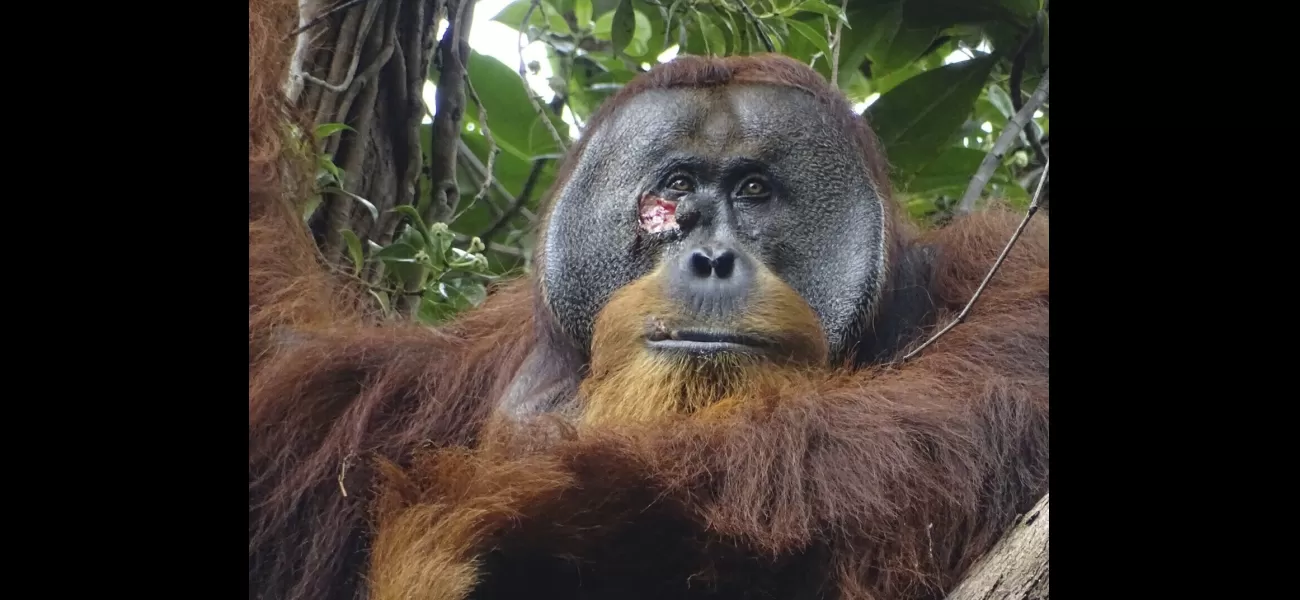Scientists report an orangutan using a plant to heal an injury in the wild.
Researchers saw Rakus eating leaves of a plant used to relieve pain and inflammation in Southeast Asia.
May 4th 2024.

According to a recent study in Scientific Reports, scientists have observed an orangutan named Rakus using a medicinal plant to treat a wound on his cheek. This is not the first time that animals have been seen using natural remedies to soothe their own ailments, but it is the first time that a wild animal has been observed directly applying a potent medicinal plant to a wound.
The intriguing behavior was first recorded in 2022 by field researcher Ulil Azhari, who works with the Suaq Project in Medan, Indonesia. The photographs taken by Azhari show the wound on Rakus' cheek closing within a month without any complications. This discovery was made in Indonesia's Gunung Leuser National Park, where orangutans have been observed since 1994. However, this behavior has not been seen before in the park, leading researchers to believe that Rakus may have learned this technique from orangutans living outside of the park and away from the daily scrutiny of scientists.
The co-author of the study, Isabelle Laumer, a biologist at the Max Planck Institute of Animal Behavior, believes that Rakus most likely got hurt in a fight with another animal. She also mentions that it is not known if Rakus had previously used this medicinal plant for other injuries. This behavior is also seen in other primates, such as Bornean orangutans who rub themselves with medicinal plant juices and chimpanzees who chew on bitter-tasting plants to soothe their stomachs.
While this may be a single observation, Emory University biologist Jacobus de Roode explains that it is not uncommon to discover new behaviors through a single observation. He also adds that this behavior is most likely self-medication as Rakus only applied the plant to the wound and no other body part. This is supported by the fact that other primates have also been observed using plants to treat themselves.
Caroline Schuppli, another co-author of the study, suggests that Rakus may have learned this behavior from other orangutans living outside the study area. This raises questions about how medicine first evolved and what we can learn from our closest living relatives. Tara Stoinski, president and chief scientific officer of the Dian Fossey Gorilla Fund, who was not involved in the study, also raises this question and emphasizes the importance of studying these behaviors in our primate relatives.
In conclusion, this study highlights the fascinating behavior of animals using natural remedies to treat their ailments and raises questions about the evolution of medicine. While this may be a single observation, it sheds light on the intelligence and resourcefulness of our primate relatives and the potential for them to teach us about the natural world.
The intriguing behavior was first recorded in 2022 by field researcher Ulil Azhari, who works with the Suaq Project in Medan, Indonesia. The photographs taken by Azhari show the wound on Rakus' cheek closing within a month without any complications. This discovery was made in Indonesia's Gunung Leuser National Park, where orangutans have been observed since 1994. However, this behavior has not been seen before in the park, leading researchers to believe that Rakus may have learned this technique from orangutans living outside of the park and away from the daily scrutiny of scientists.
The co-author of the study, Isabelle Laumer, a biologist at the Max Planck Institute of Animal Behavior, believes that Rakus most likely got hurt in a fight with another animal. She also mentions that it is not known if Rakus had previously used this medicinal plant for other injuries. This behavior is also seen in other primates, such as Bornean orangutans who rub themselves with medicinal plant juices and chimpanzees who chew on bitter-tasting plants to soothe their stomachs.
While this may be a single observation, Emory University biologist Jacobus de Roode explains that it is not uncommon to discover new behaviors through a single observation. He also adds that this behavior is most likely self-medication as Rakus only applied the plant to the wound and no other body part. This is supported by the fact that other primates have also been observed using plants to treat themselves.
Caroline Schuppli, another co-author of the study, suggests that Rakus may have learned this behavior from other orangutans living outside the study area. This raises questions about how medicine first evolved and what we can learn from our closest living relatives. Tara Stoinski, president and chief scientific officer of the Dian Fossey Gorilla Fund, who was not involved in the study, also raises this question and emphasizes the importance of studying these behaviors in our primate relatives.
In conclusion, this study highlights the fascinating behavior of animals using natural remedies to treat their ailments and raises questions about the evolution of medicine. While this may be a single observation, it sheds light on the intelligence and resourcefulness of our primate relatives and the potential for them to teach us about the natural world.
[This article has been trending online recently and has been generated with AI. Your feed is customized.]
[Generative AI is experimental.]
0
0
Submit Comment





